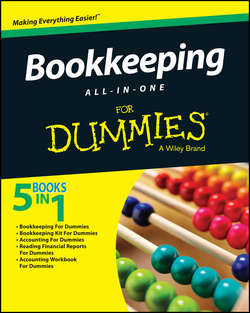Читать книгу Bookkeeping All-In-One For Dummies - Dummies Consumer - Страница 23
На сайте Литреса книга снята с продажи.
Book I
Keeping the Books
Chapter 3
The General Ledger
Developing Entries for the Ledger
ОглавлениеBecause your business’s transactions are first entered into journals, you develop many of the entries for the General Ledger based on information pulled from the appropriate journal. For example, cash receipts and the accounts that are impacted by those receipts are listed in the Cash Receipts journal. Cash disbursements and the accounts impacted by those disbursements are listed in the Cash Disbursements journal. The same is true for transactions found in the Sales journal, Purchases journal, General journal, and any other special journals you may be using in your business.
At the end of each month, you summarize each journal by adding up the columns and then use that summary to develop an entry for the General Ledger. That takes a lot less time than entering every transaction in the General Ledger.
Book I Chapter 4 introduces you to the process of entering transactions and summarizing journals. Near the end of that chapter, this entry for the General Ledger appears:
Note that the Debits and Credits are in balance – $2,900 each. Remember all entries to the General Ledger must be balanced entries. That’s the cardinal rule of double-entry bookkeeping. (For more details about double-entry bookkeeping, check out Book I Chapter 1.)
In this entry, the Cash account is increased by $2,900 to show that cash was received. The Accounts Receivable account is decreased by $500 to show customers paid their bills, and the money is no longer due. The Sales account is increased by $900, because additional revenue was collected. The Capital account is increased by $1,500 because the owner put more cash into the business.
Figures 3-1 through 3-4 summarize the remaining journal pages prepared in Book I Chapter 4, resulting in the following entries for the General Ledger:
© John Wiley & Sons, Inc.
Figure 3-1: Summarizing cash transactions so they can be posted to the General Ledger.
© John Wiley & Sons, Inc.
Figure 3-2: Summarizing sales transactions so they can be posted to the General Ledger.
© John Wiley & Sons, Inc.
Figure 3-3: Summarizing goods to be sold transactions so they can be posted to the General Ledger.
© John Wiley & Sons, Inc.
Figure 3-4: Summarizing miscellaneous transactions so they can be posted to the General Ledger.
Figure 3-1 shows a summary of the Cash Disbursements journal for a business.
The following General Ledger entry is based on the transactions that appear in Figure 3-1:
This General Ledger summary balances out at $2,050 each for the debits and credits. The Cash account is decreased to show the cash outlay, the Rent and Salaries expense accounts are increased to show the additional expenses, and the Accounts Payable and Credit Card Payable accounts are decreased to show that bills were paid and are no longer due.
Figure 3-2 shows the Sales journal for a sample business.
The following General Ledger entry is based on the transactions that appear in Figure 3-2:
Note that this entry is balanced. The Accounts Receivable account is increased to show that customers owe the business money because they bought items on store credit. The Sales account is increased to show that even though no cash changed hands, the business in Figure 3-2 took in revenue. Cash will be collected when the customers pay their bills.
Figure 3-3 shows the business’s Purchases journal for one month. The following General Ledger entry is based on the transactions that appear in Figure 3-3:
Like the entry for the Sales account, this entry is balanced. The Accounts Payable account is increased to show that money is due to vendors, and the Purchases expense account is also increased to show that more supplies were purchased.
Figure 3-4 shows the General journal for a sample business. The following General Ledger entry is based on the transactions that appear in Figure 3-4:
Checking for balance – Debits and Credits both total to $10,260.
In this entry, the Sales Return and Purchase Return accounts are increased to show additional returns. The Accounts Payable and Accounts Receivable accounts are both decreased to show that money is no longer owed. The Vehicles account is increased to show new company assets, and the Capital account, which is where the owner’s deposits into the business are tracked, is increased accordingly.
